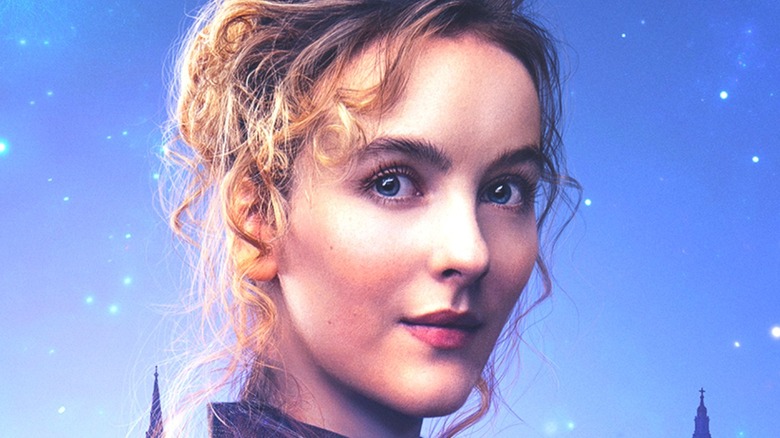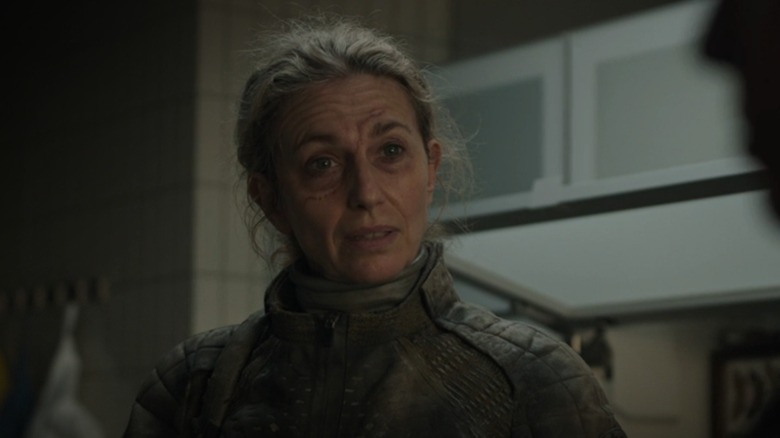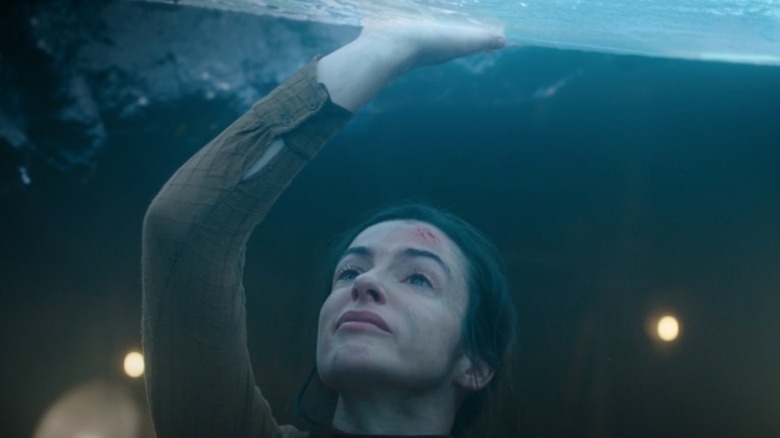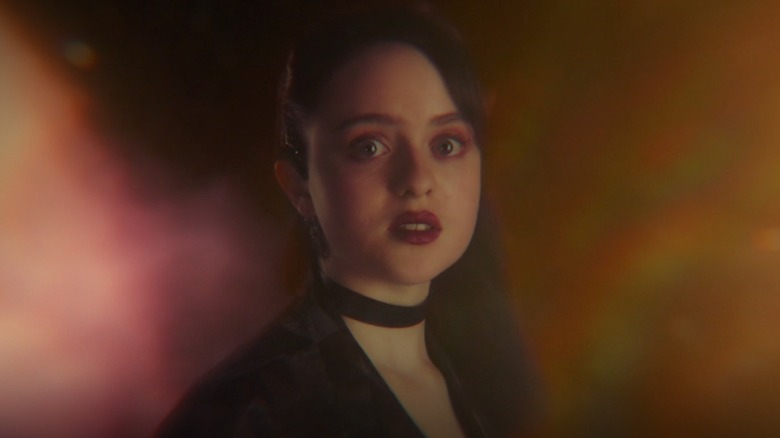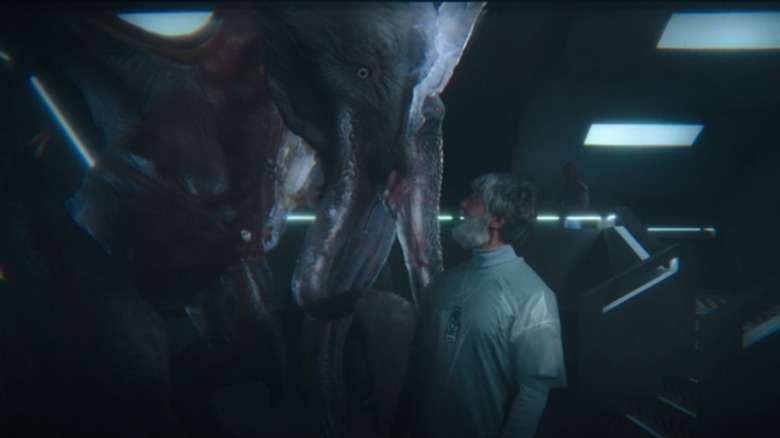The Ending Of The Nevers Season 1, Part 1 Explained
HBO Max's "The Nevers" bops between genres as nimbly as Nimble Jack. It goes from a "Heroes"-like premise in which random people have gained special powers to a "Joker"-eqsue moment of forcing one hero to pick between two people in an elaborate murder scheme, then over to steampunk with crackling inventions. It then adds in some glowing spores that seem fantasy-inspired, but are actually completely alien. Now, the ending of Season 1, Part 1 has shown its cards, revealing a story steeped in full-on sci-fi that's bordering on "Doctor Who" with its world-saving, time-traveling plot.
Up until this point, besties Amalia True (Laura Donnelly) and Penance Adair (Ann Skelly) have been running an orphanage for those who've gained strange new powers in an effort to protect them from a society that feels threatened by their very existence. Everyone calls these people the Touched, and they are mostly women and people of color. They've been hindered by a number of factors, including the Touched serial killer Maladie (Amy Manson) giving them a bad name, the highly conservative Lord Gilbert Massen (Pip Torrens) who's afraid of change, and the creepy Dr. Edmund Hague (Denis O'Hare) who's bent on experimenting on them.
The fifth episode of "The Nevers" sees Amalia and Penance split over what they think is more important — whether to answer Mary's (Eleanor Tomlinson) song and investigate this mysterious Galanthi calling to Amalia, or save Maladie from her public hanging that could have long-term consequences for all of the Touched. We proceed to follow Penance and her team as they discover Maladie's sinister plan and end with the two teams reuniting, scuffed up but all in one piece.
We don't see what happens on Amalia's mission until Episode 6, which first jumps forward in time, then back, before getting to the show's present where Amalia is searching for the Galanthi. It's a complete trip that's more than a little confusing, so here's a breakdown of what it all means.
Aliens are trying to save humanity from themselves
While the first episode of "The Nevers" saw a strange, glowing spaceship fly over London and drop ethereal motes of light on people as an explanation for how the Touched got their powers, the sixth episode gives further explanation. It begins far in the future on a ruined Earth in the middle of a war between two groups: the Planetary Defense Council (PDC) and the Free Life Army. We learn that at some point, humans ruined the planet, resulting in 5 billion deaths. Then, 20 aliens called the Galanthi came through a portal to help save humanity. They're hulking, elephant-octopus-like creatures with translucent skin and the body shape of a dinosaur, but are also playful, can form bonds with their caretakers, and can grant enhanced empathy to people. The main problem seems to be communication.
The PDC wants to embrace the Galanthi and welcome their help, believing they can make Earth livable again, but the Free Life are wary of them and have killed most of them. In the episode, we see a PDC team enter a lab in hopes of rescuing what might be the last Galanthi, but they find it's been tortured with the deaths of its scientist friends. When they discover the Galanthi portal is intended to send it away as opposed to bringing more to Earth, it destroys the hope sustaining the group. Trapped and disillusioned, they turn on each other and the hardened, cynical soldier Stripe (Claudia Black) takes her own life.
Here's where we learn the true plan: the Galanthi uses its magical glowing tentacles to transport Stripe's soul back in time, into the body of Amalia True. This time, instead of simply enhancing empathy, the Galanthi grants people special powers to save humanity earlier in time, during the Victorian era in which the series has taken place thus far. It's hoping that Stripe will aid in its efforts. We know this plan was a joint effort between the Galanthi and the scientists because Stripe found Victorian artifacts in the lab.
Amalia True is a woman from the future transported into a Victorian baker's body
Over the course of the first five episodes, the self-destructive fighter Amalia has made vague comments about being "left here" and having a mission she didn't understand. She's often been a confusing character with disparate pieces that don't make a ton of sense, even past her ability to see "ripples" of her future. However, "The Nevers" Episode 6 brings these pieces together to explain it all.
The first clue comes from a small detail. Thus far, the camera's been very interested in Amalia tapping her fingers together. When we see Stripe in the future, she has the same habit — evidently, they're the same person. Episode 6 breaks itself into different chapters to explain the complexity of who Amalia True actually is: Her body belongs to Amalia "Molly" True, a baker who married a terrible man, lived an unhappy life, and died by suicide when she jumped into the river. But while it seems Molly died there, the Galanthi saved Stripe from her own suicide attempt to put her consciousness in Molly's body. She then spent time in the same asylum as Maladie, aka Sarah, learning when and where she was and how to blend in.
As far as we viewers can tell, only Amalia's best friend Penance and her doctor-slash-lover Horatio Cousens (Zackary Momoh) know about her true past. However, she says at the end of the episode that she's going to tell everyone at the orphanage the truth and that her real name is Zephyr Alexis Navine. In her time, in the PDC, true names are kept secret, so this is a big moment of trust for her.
The Galanthi spoke to Amalia, but it was rather cryptic
Victorian-era Amalia's team mission in Episode 6 is to find the Galanthi, the great blue blob on the ceiling that Dr. Hague and the orphanage patron Lavinia Bidlow (Olivia Williams) have been excavating with their captured Touched. Initially, Amalia is upset when it doesn't do anything. "Talk to me," she says, and then it appears to do just that, only through strange visions of the past and future. These images flash quickly through the lives of Stripe, Molly, and Amalia and show things that haven't happened yet, like Massen shooting at her. Notably, Dr. Hague begins asking her a question that an unknown woman finishes: "Did you think you were the only one who hitched a ride?" This bit of dialogue seems to suggest that someone else went back in time, not just Stripe.
The vision inexplicably ends with Myrtle (Viola Prettejohn), the young girl who speaks in multiple languages all at once, against a backdrop of stars and dressed up in a new gothic outfit. She says in perfect English, "Oh, Amalia. This is a long time from that little cave. This... I will need you to forget." The "cave" could mean where Amalia is falling in the present and Myrtle could be saying that she's seeing glimpses too far forward in time. However, what this truly means is a total mystery, though it suggests there's more to Myrtle than we've been led to believe, yet Amalia won't remember it. Maybe Myrtle came from the future as well? She was the only one who could understand Mary's Galanthi song.
Then Beth (Domenique Fragale), the Touched woman who was experimented on, saves Amalia from the strange creatures that kidnapped people, suggesting Beth needs some saving herself. Amalia then tells Penance that she didn't find out who their enemy is, but she did learn something. What did she learn? That's left unclear, though it seems she gleaned more from the visions than audiences are able to.
This is just Part 1 of a two-part season
If it seems that a lot of plot threads are left untethered by the end of the episode, that's because this wasn't meant to be an ending. "The Nevers" was upended not just by the COVID-19 pandemic, like many other series coming out this year, but also by a change in showrunner. It was originally created by Joss Whedon, but he left the series amidst backlash from actors he'd previously worked with. These two factors compounded into turning the 10-episode first season into two 6-episode parts. Thus, Episode 6, "True," serves as a mid-season finale. Part 2 doesn't have a release date yet, but we do know that screenwriter Philippa Goslett ("Little Ashes") is taking over as showrunner.
So what will happen in Part 2? Well, there are many unanswered questions left and also all of humanity to save. There's a lot about the Galanthi that we still don't know — the Galanthi in the video recording doesn't exactly look like the strange mass living in the lab's ceiling nor the glowing blue thing in the Victorian-era cave, though all three are called Galanthi and are potentially the same being. Maybe the blue thing is an egg?
In the behind-the-scenes feature after the credits, writer Jane Espenson said, "The Galanthi is a highly-evolved, benevolent, intelligent, emotional alien. It has found a particularly difficult species to help elevate." Barring another big reveal that the Galanthi are secretly evil, it seems as if this story is about whether humans can accept help and enact real change. It also appears possible that the Galanthi purposefully put power into the hands of oppressed people — largely women and people of color — to save humanity. That may be their grand plan: to upend the balance of power.
